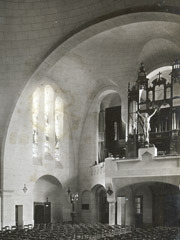Voir aussi

To learn more about Aristide Cavaillé-Coll
The website of the Cavaillé-Coll Association
The site of the French Culture Ministry devoted to Aristide Cavaillé-Coll
At Bécon-les-Bruyères, the new church of Saint-Maurice came into being shortly after the fraught separation of Church and State. In a militant gesture, its founder, Canon Oudin, symbolically sought only the best in the furnishings for this edifice.  He boldly requested an extension of the organ loft in order to house an organ worthy of gracing this new place of worship. The instrument was re-erected by Charles Mutin in 1912 with a few adjustments to the disposition of the new location. The dedication took place on 6 April 1913 by Eugène Gigout (1844-1925), composer and organist at Saint-Augustin in Paris.
He boldly requested an extension of the organ loft in order to house an organ worthy of gracing this new place of worship. The instrument was re-erected by Charles Mutin in 1912 with a few adjustments to the disposition of the new location. The dedication took place on 6 April 1913 by Eugène Gigout (1844-1925), composer and organist at Saint-Augustin in Paris.
While its relocation meant saving it from the flames, relocation nonetheless made for an alteration of Cavaillé-Coll’s original work. The foremost modification was of course the adaptation to a new location: the organ loft at Saint-Maurice does not have the dimensions that would allow retaining the original layout. Thus Mutin made the decision to relocate the chest and pipework of the Récit divison, from a central rear position to a new, offset and much more foreward position. This transformation resulted in the complete breaking down of the balances intended by Cavaillé-Coll between each of the divisions.
Between 1925 and our time, surely because free reeds were no longer in vogue, the Physharmonica was taken out, although, as we have seen, it was one of the main hallmarks of the instrument.
In 1976, it was also this notion of updating that guided Jean Jonet in his work. He removed two stops deemed too “romantic,†replacing them with mutation stops such as could be found in 18th-century organs; at the time the “neoclassical†organ, in its worst manifestation, reigned supreme. Following the same logic, he exchanged stops between the Positif and Récit divisions, modified the composition of the Progressio harmonica mixture, cut down harmonic flutes, significantly softened the voicine... all with the aim of allowing the performance of 17th- and 18th-century music… on an organ from the following century. Along with these interventions in the pipework, Jonet totally passed over the overhaul of the action and winding circuit, despite the crucial importance thereof.
The organ was registered as a Historical Monument in 1985.
Thirty-five years hence, all these alterations in the original esthetic of the organ are still present and cry out to be rectified, which entails a huge amount of work: reconstruction of missing pipes, lengthening of the cut-down pipes, displacement of the entire Récit division, reinstating the Physharmonica… While these esthetic matters are perceptible to any attentive listener, there exist in this organ more treacherous defects: the aforementioned problems in the action and winding system, and more generally all the technical devices of the organ. For example, the windchests, pivotal elements of an organ that alllow distribution of the wind according to the notes played and stops drawn, have lost a great deal of their airtight construction, resulting in the sounding of numerous unwanted notes.

In the spring of2010, the advanced state of wear in the action forced the Association to forego any further concert organiezation, since the organ ran the constant risk of producing a major breakdown which would make it essentially unplayable.